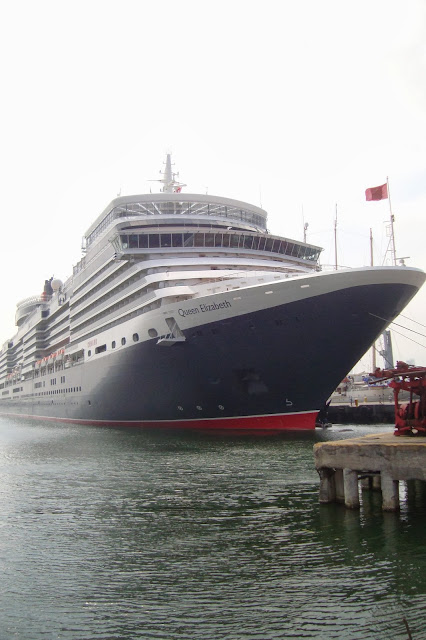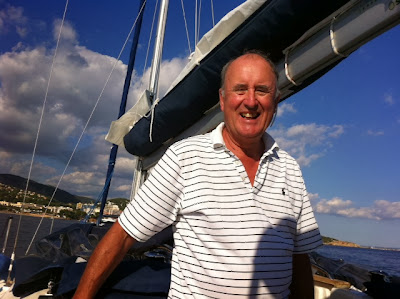The itinerary in the Pacific looked sensational. Clearly more than 1500 others thought the same as they boarded Queen Elizabeth in Los Angeles in early February 2013.
The prospect of visits to Hawaii, Samoa, Tahiti, Bora Bora and New Zealand was irresistible. And additionally we were to cross both the Equator and the International Dateline twice.
Honolulu was the first call and as we had been to Oahu and the Pearl Harbour Memorials before, we returned to Waikiki and to the memories of our visit seven years earlier. We had stayed then in the magnificent Moana Surfrider, the first hotel ever built on Waikiki Beach, and it was as elegant as ever with a massive Banyan tree in the courtyard by the beach. Many of our fellow passengers went to Pearl Harbour and they inevitably found the USS Arizona memorial very moving. It is a must if you visit Honolulu.
We then sailed south to the Equator and on 12 February King Neptune and his Queen came aboard and on a beautiful sunny day performed the traditional crossing the line ceremony.
We arrived at Pago Pago in American Samoa – a lush tropical island – on Valentines Day. An amiable taxi driver took us on a long tour of the island said by some to be the birthplace of Polynesion culture. The island is beautiful.
The following day we were in Samoa (formerly Western Samoa) and we visited Robert Louis Stevenson’s house (now a museum) where he spent the last four years of his life. He is buried nearby on Mount Vaea. We then travelled south, passing the beautiful Papapapaitai waterfall, to the idyllic beaches on the south coast. Parts of the capital Apia were devastated by a cyclone last December. Homes were flattened and cars washed away but those affected are putting on a brave face as they clear the debris.

From the Samoan islands we then had three days at sea before our arrival in Auckland. The weather was marvellous and we had four wonderful days in New Zealand. Auckland was followed by Tauranga, Napier and then Wellington.
In Napier the vintage motor cars were out in force, their drivers in period costumes to complement the Art Deco architecture prominent in the town. The centre of the town was destroyed by an earthquake in 1931 and it was reconstructed in the Art Deco style. The following day in Wellington many of us were at the Harbourside where masses of teams were assembling in Frank Kitts Park for Dragon Boat racing. Once underway the racing was fierce and exciting.
Tahiti was possibly the highlight of the voyage. After five days at sea we arrived in Papeete. The island of Tahiti is the highest and largest in French Polynesia and consists of two parcels of land joined by an isthmus. Our driver took us round the coast in a clockwise direction from Papeete and at the isthmus drove up into the lush green cattle country where the view of Tahiti was spectacular. Tahiti is close to the ideal of a tropical paradise.

Of course we all remember the film South Pacific with its beautiful girls. They are still there and it is easy to understand why the Bounty mutineers were reluctant to leave Tahiti after five months tending their breadfruit and their relationships with the local ladies. They dreaded the voyage ahead of them. We would have preferred to stay longer but looked forward to further travels in the wonderful Queen Elizabeth in Polynesia and the Hawaiian islands.
We were in Bora Bora the following day and as we edged in past the coral reefs, sadly the sun was not shining and rain was forecast. But that did not deny us a trip to Bloody Marys for an expensive drink of that name. The island evokes memories of Bali Hai but the movie was filmed elsewhere. The island is wonderful and is surrounded by a lagoon and a barrier reef.
Queen Elizabeth headed north again towards the Hawaiian islands. Hilo on Big Island was our next call and after the Rainbow Falls we visited the impressive Hawaii Volcanoes National Park with views across the crater. The volcanoes are described as ‘active’ and the museum in the National Park is excellent.
Our final call was to the island of Maui. We drove south to Kihei and our driver was keen to show us the holiday homes of Jack Nicholson and Tiger Woods before embarking on a drive through the lava fields. We then headed north through the beautiful homes in Kula before rushing back to the ship from the Tedeschi Winery. Maui is clearly an island with much to offer. We merely scratched the surface but vowed to return one day.
Throughout the voyage we heard stories of Captain James Cook and in the South Pacific and in Tahiti in particular stories of HMS Bounty, Lt William Bligh and Fletcher Christian. The history of exploration in the Pacific in the 1700’s is fascinating and Cook’s three voyages between 1768 and 1779 took him all over the South Pacific and wherever we went we found evidence of his exploits.

It has not escaped our notice that the Queen Victoria will be in the South Pacific in February 2014. No doubt many of our fellow Queen Elizabeth passengers will find it hard to resist a return to that ocean next year. We will certainly be there.

.jpg)













